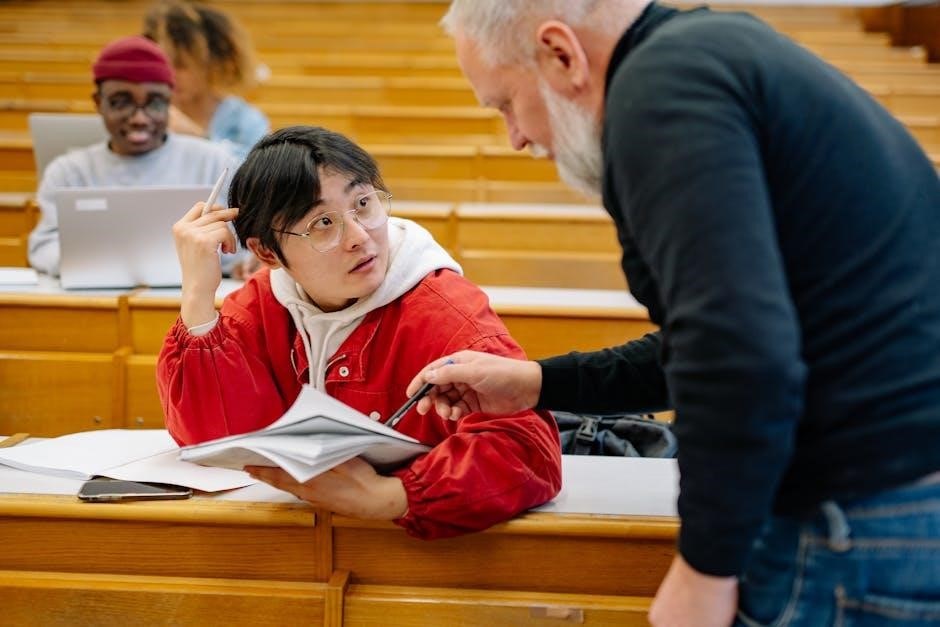
The Canterbury Tales Prologue, written by Geoffrey Chaucer, introduces a diverse group of pilgrims traveling to Canterbury Cathedral. It sets the stage for their stories, highlighting their social roles and personalities, while establishing themes of spring renewal and societal structures.
1.1 Overview of the General Prologue
The General Prologue of The Canterbury Tales serves as the introductory section, setting the stage for the pilgrimage to Canterbury Cathedral. It opens with a vivid description of spring, symbolizing renewal, and introduces a diverse group of pilgrims gathered at the Tabard Inn in London. Chaucer, as the narrator, joins this assortment of characters, ranging from nobles to commoners, each representing different social classes and moral perspectives. The prologue not only establishes the framework for their journey but also highlights the contrasts between their spiritual intentions and worldly concerns. Its rich imagery and characterizations provide a foundation for understanding the themes and narratives that follow.

1.2 Importance of the Prologue in the Context of the Entire Work
The General Prologue is crucial as it establishes the framework for The Canterbury Tales, introducing characters and themes that resonate throughout the work. It sets the pilgrimage in motion, showcasing a cross-section of medieval society and their motivations for traveling to Canterbury. The prologue not only introduces the pilgrims but also highlights their social roles, moral values, and personal quirks, which become central to their tales. By presenting these characters, Chaucer creates a dynamic interplay of perspectives, laying the groundwork for exploring themes like class, religion, and human nature. This introductory section is essential for understanding the narratives and conflicts that unfold in the tales that follow.

Key Characters Introduced in the Prologue
The General Prologue introduces a diverse group of pilgrims, showcasing their social roles, occupations, and personalities, which later influence the tales they narrate during their journey to Canterbury.
2.1 The Pilgrims: Their Roles and Significance

The pilgrims in Chaucer’s Prologue are meticulously crafted to represent various facets of medieval society, from the noble Knight to the cunning Wife of Bath. Each character’s role reflects their social status, occupation, and moral standing, providing a vivid snapshot of the era’s diverse population. Their significance lies in how they embody human virtues and vices, offering insights into the societal hierarchies and values of the time. By introducing such a wide array of characters, Chaucer sets the stage for the exploration of universal themes through their individual tales, making the Prologue a foundational element of the entire work.
2.2 The Wife of Bath: Her Character and Relevance

The Wife of Bath stands out as one of Chaucer’s most dynamic and memorable characters. She is a robust, independent woman with a sharp tongue and a wealth of life experience. Married five times, she embodies a challenge to medieval gender norms, advocating for female autonomy and sexual freedom. Her relevance lies in her bold defiance of societal expectations, offering a feminist perspective rare for her time. Through her, Chaucer critiques the patriarchal structures while celebrating female resilience, making her a central figure in the exploration of themes like marriage, power, and identity throughout The Canterbury Tales.

Frequently Asked Questions About the Prologue
Q: Why is the Prologue important? A: It introduces characters, themes, and societal norms, setting the stage for the Tales. Q: What motivates the pilgrims? A: They seek spiritual renewal and share stories, reflecting diverse medieval life experiences.
3;1 Why is the Prologue So Important?
The Prologue is essential as it introduces diverse characters, establishing their roles and societal standings, while setting the thematic foundation for the tales. It provides context for understanding the pilgrims’ backgrounds and motivations, linking their stories to broader social and moral themes. Additionally, it showcases Chaucer’s narrative technique, blending humor and satire to critique medieval society. The Prologue’s vivid descriptions and characterizations create a dynamic framework, enriching the storytelling experience and highlighting universal human experiences that resonate beyond the medieval period.
3.2 Questions About the Pilgrims and Their Journeys
Questions about the pilgrims and their journeys often focus on their motivations, social roles, and interactions. Why do they embark on the pilgrimage to Canterbury? How do their professions and backgrounds influence their storytelling? The pilgrims represent diverse social classes, from nobility to commoners, highlighting Chaucer’s exploration of medieval society. Their travels also raise questions about morality, faith, and personal growth. Analyzing their dynamics reveals themes of community and conflict, while their stories reflect broader societal values. These inquiries deepen understanding of Chaucer’s critique of his era and the universal human experiences portrayed in the tales.
The Wife of Bath’s Prologue and Tale

The Wife of Bath, a prominent character, shares her experiences on marriage and sovereignty. Her prologue reveals her five marriages, while her tale explores themes of gender roles and power dynamics.
4.1 Key Questions About Her Story
Key questions about the Wife of Bath’s story include her motivations for marrying multiple times and her views on gender roles. Her experiences shape her narrative, offering insights into medieval societal expectations. Questions also arise about the theme of sovereignty and its relevance to her tale. Additionally, her character challenges traditional norms, prompting queries about her influence on the other pilgrims and her role in Chaucer’s exploration of power dynamics. These questions highlight her complexity and the broader themes she represents in the Canterbury Tales.
4.2 Analysis of Her Character and Themes
The Wife of Bath is a dynamic character, known for her assertiveness and defiance of medieval gender norms. Her five marriages and outspoken nature challenge societal expectations, making her a symbol of female agency. Themes in her story include sovereignty, marriage, and power dynamics, reflecting Chaucer’s exploration of gender roles. Her character also embodies the tension between religious teachings and personal autonomy. Through her tale, Chaucer critiques societal structures while presenting a complex, multifaceted woman. Her experiences as a weaver and traveler add depth, showcasing her resilience and wit. These elements make her one of the most memorable and analyzed characters in the Canterbury Tales.

Themes and Symbolism in the Prologue
The Prologue explores themes of renewal and societal critique, symbolized by spring’s arrival. It highlights pilgrims’ diverse backgrounds, reflecting medieval social structures and moral complexities.
5.1 The Representation of Spring and Its Significance
Spring in the Prologue symbolizes renewal and new beginnings, mirroring the pilgrims’ spiritual journey. Chaucer uses vivid imagery of April showers and blooming fruit to evoke hope and transformation, setting a backdrop for the diverse narratives to unfold. This seasonal motif not only reflects natural cycles but also underscores the characters’ individual and collective quests for redemption and self-discovery. The imagery of spring serves as a metaphor for the pilgrimage itself, emphasizing themes of renewal and the possibility of change amidst the societal norms of medieval England.

5.2 Social Structures and Values in the Prologue
The Prologue reflects the social hierarchy of medieval England, showcasing pilgrims from diverse backgrounds. Chaucer portrays characters like the Knight, representing nobility, and the Wife of Bath, embodying middle-class vitality, to illustrate class distinctions. The clergy, such as the Pardoner and the Friar, are critiqued for their corruption, highlighting religious hypocrisy. These portrayals reveal the societal values of the time, including the importance of religion, social status, and moral expectations. Chaucer’s satire subtly critiques these structures while providing insight into the lived experiences of his characters, offering a nuanced view of late medieval society and its complexities.
Resources for Further Study
Explore recommended PDF guides, interactive quizzes, and study materials to deepen your understanding of the Prologue. Online resources offer comprehensive analyses and test your knowledge effectively.
6.1 Recommended PDF Guides and Study Materials
Various PDF guides and study materials are available to aid in understanding the Canterbury Tales Prologue. These resources include detailed analyses, character breakdowns, and historical context. Literature unit plans offer structured approaches, covering the Prologue and selected tales. Additionally, PDFs with questions and answers provide comprehensive study aids for students. Online platforms like Google Scholar and educational websites host these materials, ensuring accessibility. They are designed to enhance comprehension and preparation for exams or discussions. Utilize these resources to explore themes, characters, and literary devices in depth, making your study of the Prologue more engaging and effective.
6.2 Online Quizzes and Interactive Resources
Online quizzes and interactive resources offer engaging ways to test knowledge of the Canterbury Tales Prologue. Websites provide multiple-choice questions, true/false assessments, and fill-in-the-blank exercises. Interactive platforms allow learners to explore character profiles, plot summaries, and thematic analyses dynamically. Tools like Kahoot! and Quizlet host user-friendly activities for classroom or self-study use. These resources are designed to reinforce understanding of Chaucer’s work, making complex concepts more accessible. They also cater to different learning styles, ensuring a comprehensive grasp of the Prologue’s themes, characters, and historical context. Utilizing these resources can enhance study sessions and prepare students for in-depth discussions or exams.